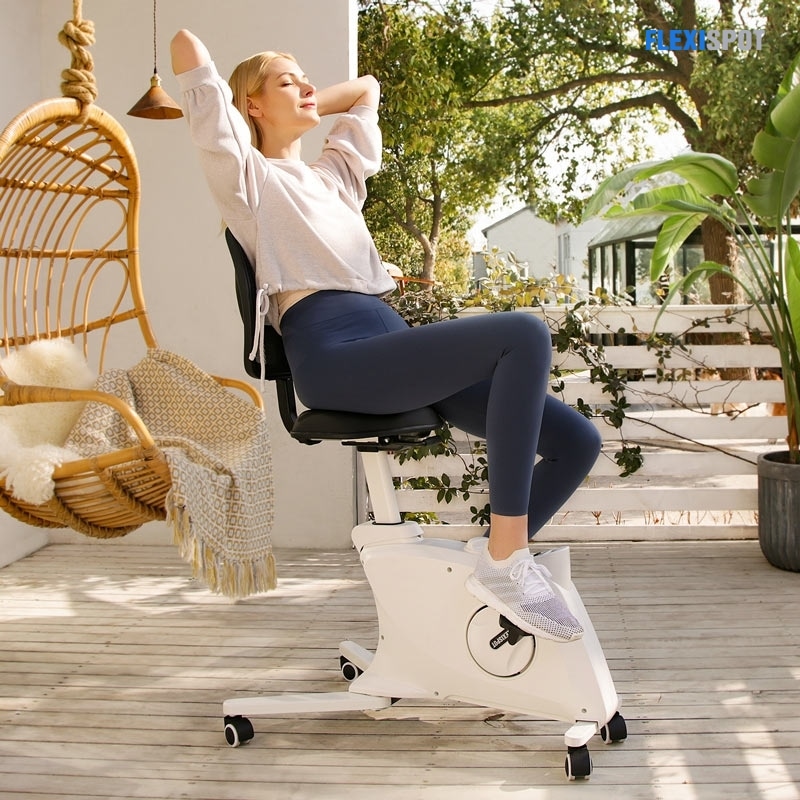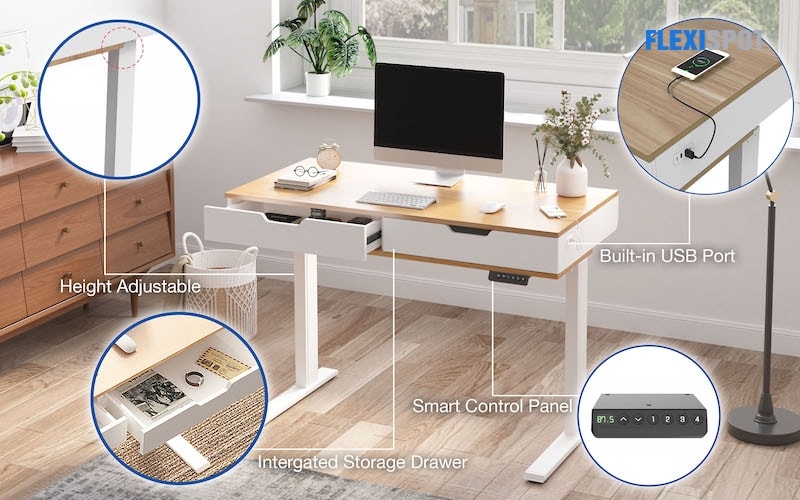A sedentary lifestyle is like a slow poison. Like smoking piles of weed daily, it gradually chips off your health till you're fickle enough to develop dangerous diseases.
Unfortunately, some of us can't avoid this "slow poison" completely. Now that the work from home model is a thing, most of us are stuck with our desks, working nonstop.
But you don't have to be a victim of the dangers this lifestyle harbors. There are viable ways to get active during the day and reduce your inactive hours.
One of the most popular is investing in an ergonomic standing desk. Standing desks have grown to become an antidote to the dangerous sedentary lifestyle. With an adjustable sit-stand desk, you can switch between standing and sitting poses with a click.
And if you use it effectively, it can help resolve any back and neck pain you've developed while sitting for prolonged hours. How do you use a standing desk effectively? You’ll find out soon.
You don't have to struggle with your sit-stand desk any longer; this article entails tips to help you use your standing desk like a pro.
Ready to find out? Keep scrolling; we promise this read would be enlightening.
Learning how to use a standing desk the right way
The health risks of a sedentary lifestyle don't stop with buying height adjustable standing desks.
You can own an ergonomic desk and still hang on to unhealthy habits. Luckily for you, we've taken time to highlight foolproof tips to help use your sit-stand desk to its full potential.
Let's dive deep and set you on the path of leading a healthy lifestyle.
1. Move while using a standing desk
Don't make the mistake of being static by your standing desk. Sitting for a long time is harmful, so is standing "in actively" for prolonged hours.
While using a sit-stand desk, the idea isn't necessarily to remain on your feet; the idea is to switch between the two postures. Or, while standing, you can try some simple exercise like leg raises to regularize blood circulation.
Alternatively, you can take short walks around your workspace; or take a compulsory lunch break at a specified time daily. When you walk around during work, you give your brain a few moments of rest. And you'd be surprised at how beneficial these short walks could be.
Another way to stay active during work is by investing in a fitness chair. An example is flexispot’s sit2go 2-in-1 fitness chair. With this fitness chair, you can take healthy strides while working by your adjustable standing desk.
2. Have sitting and standing intervals
The exciting feeling that comes with buying a new workstation instigates a couple of shoddy work postures. We'll explain how.
People have the wrong impression that a standing desk is solely for working on your feet. Once they buy one, they switch to working on their feet for extended hours, hoping to counter the risks of sitting for long.
Studies show that sitting for too long is a fast way to get unhealthy. Standing for an extended period also opens you up to other risks. Hence, it’s better to alternate between sitting and standing while you work.
Have specified times for both postures; you can have 30 minutes standing for each hour you spend on your seat. That's a trick that keeps you active. And don't hesitate to take mild exercises by your desk each time the opportunity arises.
However, if you are accustomed to sitting for prolonged hours; standing for an hour, for instance, maybe a sudden change. It would take a while before your body adjusts to it.
3. Put a soft base under your feet
The same way your back and neck bear the brunt of sitting for long, your leg takes the hit when you stand for a prolonged time. But like sitting, there's a solution to ease pains from your legs. You can invest in the best anti-fatigue mat for standing desks. Or you could get a flow board to make standing less detrimental.
An anti-fatigue mat relieves your feet from the pressure of carrying your weight. Hence, to prevent health issues from unbalanced feet or poor blood circulation, get a soft platform for your feet.
Ensure it’s soft and comfortable enough to avoid triggering other complications.
4. Watch your standing posture
There's such a thing as a proper standing posture. And if you develop a terrible standing posture, your standing desk won't make a difference. It would be like fleeing one unhealthy act only to sink into another.
It would help if you learned how to stand correctly while using a standing desk. Avoid bending over your desk or bending your neck while working with a sit-stand desk. The best standing posture has your back straight with your toes pointed forward, and your feet leveled on a soft platform or the ground.
Although keeping a straight back and leveled shoulder might be daunting initially, it will get better and become more natural over time.
5. Preset your ergonomic workspace
Buying a desk with an extensive adjustability feature has numerous benefits. One of the most prominent ones is that it allows you to set any desk height comfortably.
An adjustable desk must be at a height that places the monitor at the same level as your eyes. This ensures you don't have to struggle or bend your back to work on your monitor.
6. Adjust your mouse and keyboard position
Straining your wrist comes with excruciating pain, one that you can very well avoid from the get-go. Using your keyboard and mouse for a long requires a perfect position for your wrist because positioning is vital to ease pressure and prevent pain.
The best position is to have your wrist tilted upward, a little above the level the sitting position requires. If your standing desk’s height is accurate and you still have your wrist positioned wrongly, raise your keyboard to a convenient level.
Additionally, keep your keyboard and mouse at your chest level to keep health issues like tennis elbow at bay. So, besides the aesthetics of a stand-up desk, check for features like adjustability to know if the height would serve its purpose.
7. Hold your shoulders appropriately
We all tend to slouch while working on the computer. For some people, it’s a habit, while others tend to skid close to the computer to see the display. But this doesn’t make the posture right.
Always make your shoulders straight and be cautious enough to keep it that way throughout your workday. Whenever you find yourself slouching, do some shoulder rolls and make your shoulders straight.
A regular shoulder roll exercise could help you develop the habit faster. Before you know it, you’ll have a perfect shoulder posture by default.
8. Avoid the infamous lean
You may not do this consciously, but we are all inclined to lean in a while working on our feet. It’s the infamous posture that some of us believe we need to get past work. However, the positive impact that a standing desk has would dissipate if you groom this posture.
Don’t blame yourself for wanting to lean infrequently; catch and correct the posture each time you do. Be deliberate and persistent about weaning yourself off it, and you'd form a healthy natural pose eventually.
9. Get arm support
Your arm may seem like a minor consideration, but you don’t want to end up nursing tennis elbow or something worst. While using a standing desk, your arm must form a natural angle 90 from the desk.
Furthermore, ensure you don’t leave your arms hanging in an unnatural position. Your wrist is another delicate part of your body. To avoid issues, let your keyboard be at your chest level and perform simple arm exercises often. The exercises ease out the tension in your muscles.
Additionally, don’t buy an ergonomic chair without solid arm support. So, even while you're sitting, you must have arm support to keep your arms in the best posture.
10. Adjust the height of your Ergo chair
Bad sitting posture is a common practice in the workspace. But you can curb it with ease. All you need is the best adjustable ergonomic chair.
An ergo chair with adjustability settings allows you to adjust your chair in a way that promotes good posture.
While sitting, ensure the top of the seat cushion is parallel to your knee and keep your knees bent at angle 90. Your feet must also be parallel to the ground. This is the proper posture that helps keep back pain in check.
11.Take breaks
Besides the occasional short walks in between work, take breaks. Your productivity is like a fuel tank; when you use it without replenishing, it deteriorates until it depletes completely.
So, take a break when you believe it’s necessary. Take a walk, grab some launch, or do something that helps you unwind. Afterward, rest assured that work will become a cinch.
12.Track your steps
Keep track of your movement while using a standing desk. By default, you will find yourself moving while using a sit-stand desk. This is why experts recommend this desk type as a healthy way of staying active.
But you can make it even more healthy by tracking your movements with a smartwatch or your phone. Set a walking or movement goal daily and strive to achieve it during work to ensure you keep track of your wellbeing.
13. When you can't move, fidget
Weird, right? But the truth is, you can’t always have the opportunity to move; sometimes, your productivity level is at its peak, and you can’t afford any distraction. You can fidget instead.
Fidgeting is one of the most natural movements. Although it’s often a sign of nervousness, you can create an active workday out of it.
Moreover, it’s a spontaneous act that doesn’t require too much effort or willpower. Like the Nike mantra that keeps everyone on their toes, we would say, "just do it."
14. Adjust your monitor height
When your monitor’s height is at an unnatural angle, you will end up resolving to an unnatural position to work on it. And this never ends well; you either end up with neck pain or backache.
You can avoid this by adjusting your monitor height via an adjustable monitor arm. The right position for your monitor is your eye level without being too close to your eye.
Ideally, when you stretch your hands forward, only your fingertips should touch the screen.
15. Make use of the memory settings
You don’t have to break a bank to buy the best standing desk on the market. And if you own one, it offers you various features like memory settings. Buying a subpar desk on the flip side offers you broken comfort.
Memory settings in a standing desk allow you to set a specific desk height suitable for you without resetting it each time you use the desk.
Hence, you will have your standing desk customized to offer you comfort with little or no effort from you.
Bottom Line
Buying an adjustable standing desk isn’t an assurance of good health. But using it like a real pro is well-being at its peak. We hope that our tips have helped you discover the bad habits you have picked since you started using your standing desk.
Living a healthy work-life requires more than a workstation; it takes conscious and deliberate effort as well.





